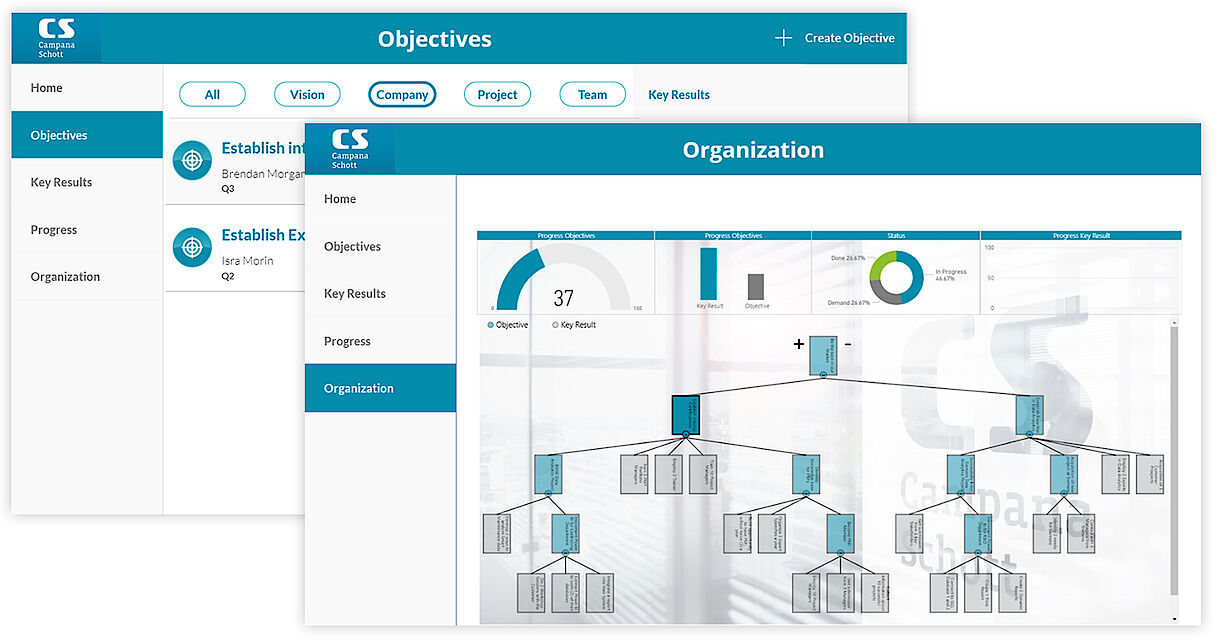In the course of the digital transformation, companies must be able to quickly respond to changes and streamline cumbersome and hierarchical decision-making process. The introduction of “Objectives and Key Results” (OKR) on a central platform can lead to more flexible and adaptive organizational forms.
A familiar scenario: A customer calls, a colleague is asking for information and urgent e-mails are waiting in the mailbox - all at the same time. In today's work environment, employees frequently have to look after several tasks simultaneously - as the pace continue to increase. Under these conditions, they find it virtually impossible to pursue their own and the company objectives.
However, that applies not just to employees but also the entire company: The present environment is characterized by rapid change, high complexity, global connectivity and continuous transformation. And the speed of change will continue to increase in the coming years - driven by artificial intelligence, IoT and data-driven business models.
This means that companies need agile and adaptable forms of organization. The target system in particular represents a key aspect for the management and direction of an organization. Accordingly, the introduction of “Objectives and Key results” (OKR) is one component of an agile transformation process.
What are Objectives and Key Results?
OKR is a management instrument that was developed at Intel in the 1970s, and which became more widely used (particularly in large tech corporations) starting in the late 1990s. It means that the orientation of the entire organization to the company objectives is used as a management instrument.
Compared to agile methods at the level of individual projects, OKR can therefore be understood as an agile management instrument across different hierarchy levels in a company - from the level of the entire company down to individual employees. Everyone pursues his or her specific objectives, which in turn are derived from the overall strategy. In this context, OKR should:
- be defined, reviewed and adjusted during the year
- be focused on a few but central objectives
- be visible to all employees
- be motivating and difficult to achieve (Objectives)
- be measurable and precisely describe the target status (Key results)
Advantages & applications
With this simple concept, OKR are easy to understand and efficient to implement. The review and adjustment of OKR during the year guarantee a rapid response to changes and thus promote the company's agility. The regular coordination of employee, project, divisional and company objectives, combined with a concentration on a few central objectives, also ensures that double work and work on low-priority issues can be avoided. In this way, resources can be used across the different “silos” and in a profit-maximizing manner.
This level of transparency allows employees to see their own contribution to the higher-level objectives, while also being involved in the target formulation process. This increases their motivation to reach their own objectives. In addition, the objectives are aligned to the company's strategy, so that each organizational unit is working towards its implementation. The “Key Results” represent measurable results that can be used to verify the employee's target attainment up to the level of the company objectives.
The development of a more agile organization of companies is another application field of OKR. In this vein, project and non-project worlds can be linked together - regardless of whether they are agile (or not).
Transparency through a central platform
Today, many management approaches are based on decentralized and non-public tools such as Excel calculations or PowerPoint reports. Accordingly, the objectives and assessment of progress that are documented in the same are not made transparent. But an essential feature of OKR is that the method is accepted and practiced by employees and management alike. Therefore, these traditional tools are not suited for OKR. The tool that is used must facilitate the simple entry and transparent representation of objectives, expected results and the correlations between the objectives. This is the only way to realize the advantages of OKR.
Using the Microsoft Power Platform as the basis, Campana & Schott developed a solution that meets the OKR requirements. The tool provides a centralized representation of the objectives at the different levels of the organization, which is accessible to all employees. The tool can be used to document, monitor and illustrate all OKR across divisional boundaries. Through the visual representation of the hierarchical context, each employee and each organizational level can see how their own objectives have their place in the company's overall objectives. This ensures the required level of company-wide transparency using a tool as a “single point of truth”.
With the Microsoft Power Platform, the solution can be seamlessly integrated into the digital workplace and therefore makes a significant contribution to a successful outcome. Information from other tools that are based on the Microsoft technology (e.g. Project Online/Project Server, Planner, Dynamics 365 PSA or SharePoint) can also be connected. In this way, particularly project and non-project worlds can be linked and centrally managed within organizations.

